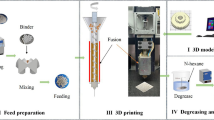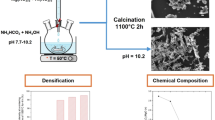The paper presents the results of studying the processes of synthesizing baddeleyite-zircon ceramics based on fluorinated plasma dissociated and natural zircon. It was found that obtaining densely sintered ceramics based on fluorinated natural zircon requires the addition of CaO to stabilize free ZrO2 contained in it. The addition of Y2O3 to the plasma dissociated zircon-based ceramic materials makes it possible to reduce the sintering temperature from 1,600 to 1,500°C. Obtaining highly fluorinated plasma dissociated zircon-based ceramics is complicated due to the formation of excessive amount of ZrF4.







Similar content being viewed by others
References
F. Nakamori, Y. Ohishi, H. Muta, et al., “Mechanical and thermal properties of ZrSiO4,” J. Nucl. Sci. Techn., 54(11), 1267 – 1273 (2017). https://doi.org/10.1080/00223131.2017.1359117.
J. Varghese, T. Joseph, and M. T. Sebastian, “ZrSiO4 ceramics for microwave integrated circuit applications,” Mater. Lett., 65(7), 1092 – 1094 (2011). https://doi.org/10.1016/j.matlet.2011.01.020.
G. N. Maslennikova and I. V. Pishch, Ceramic Pigments, 2nd ed. [in Russian], OOO RIF “Stroymaterialy,” Moscow (2009).
Y. Shi, X. Huang, and D. Yan, “Synergetic strengthening and toughening of zircon ceramics by the additions of SiC whisker and 3Y-TZP simultaneously,” J. Eur. Ceram. Soc., 17(8), 1003 – 1010 (1997). https://doi.org/10.1016/S0955-2219(96)00185-9.
Y. Shi, X. Huang, and D. Yan, “Mechanical properties and toughening behavior of particulate-reinforced zircon matrix composites,” J. Mater. Sci. Lett., 18, 213 – 216 (1999). https://doi.org/10.1023/A:1006672131378.
C. Wang, Q. Wang, K. Liu, et al., “Synthesis, characterization and application of submicron ZrSiO4 powder via sol-gel-microemulsion-hydrothermal method,” J. Alloys Compds., 828, 1 – 11 (2020). https://doi.org/10.1016/j.jallcom.2020.154332.
N. M. Rendtorff, S. Grasso, C. Hu, et al., “Zircon-zirconia (ZrSiO4-ZrO2) dense ceramic composites by spark plasma sintering,” J. Eur. Ceram. Soc., 32(4), 787 – 793 (2012). https://doi.org/10.1016/j.jeurceramsoc.2011.10.021.
Y. Shi, X. Huang, and D. Yan, “Fabrication of hot-pressed zircon ceramics: mechanical properties and microstructure,” Ceram. Int., 23(5), 457 – 462 (1997). https://doi.org/10.1016/S0272-8842(96)00057-0.
L. D. Kock, M. D. S. Lekgoathi, E. Snyders, et al., “The determination of percentage dissociation of zircon (ZrSiO4) to plasma-dissociated zircon (ZrO2·SiO2) by Raman spectroscopy,” J. Raman Spectr., 43, 769 – 773 (2012). https://doi.org/10.1002/jrs.3090.
N. M. Rendtorff, G. Suarez, M. S. Conconi, et al., “Plasma dissociated zircon (PDZ) processing; influence of the Zr:Si ratio in the composition, microstructure and thermal re-crystallization,” Procedia Materials Science, 1, 337 – 342 (2012). https://doi.org/10.1016/j.mspro.2012.06.045.
S. Yugeswaran, P. V. Ananthapadmanabhan, T. K. Thiyagarajan, et al., “Plasma dissociation of zircon with concurrent in-flight removal of silica,” Ceram. Int., 41(8), 9585 – 9592 (2015). https://doi.org/10.1016/j.ceramint.2015.04.020.
R. McPherson, R. Rao, and B. V. Shafer, “The re-association of plasma dissociated zircon,” J. Mater. Sci., 20, 2597 – 2602 (1985). https://doi.org/10.1007/BF00556091.
R. C. Garvie, “Improved thermal shock resistant refractories from plasma-dissociated zircon,” J. Mater. Sci., 14, 817 – 822 (1979). https://doi.org/10.1007/BF00550712.
J. P. H. Williamson and D. E. Lloyd, “The characterization of ceramic bodies produced from plasma dissociated zircon,” J. Mater. Sci., 16, 1264 – 1272 (1981). https://doi.org/10.1007/BF01033841.
T. V. Vakalova, V. V. Kravchenko, and V. V. Gorbatenko, “Physico-chemical features of the synthesis of mullite in mixtures of quartz-pyrophyllite rock with a fluoride-forming component,” Refract. Ind. Ceram., 55, 2, 131 – 136 (2014).
T. V. Vakalova, V. I. Vereshchagin, V. V. Gorbatenko, et al., “The use of topaz-containing raw materials in the technology of alumino-silicate refractories,” Ogneupory i Tekhnicheskaya Keramika, No. 9, 42 – 47 (2007).
A. A. Smorokov and R. I. Kraidenko, “Production of zirconia dioxide using ammonium fluorides,” Polzunovskii Vestnik, No. 3, 126 – 160 (2017).
Yu. A. Simonov, A. A. Kritskii, V. N. Rychkov, and V. A. Tomashov, “Investigation of the treatment process of associated dioxides of zirconium and silicon by an aqueous solution of ammonium fluoride,” Russian Journal of Non-Ferrous Metals, 51, 320 – 323 (2010). https://doi.org/10.3103/S1067821210040115.
G. A. Farnasov and A. B. Lisafin, “Dissociation of zircon after treatment in high-frequency induction air plasma,” Fizika i Khimiya Obrabotki Materialov, No. 2, 29 – 34 (2015).
Sh. M. Sharafeev and V. I. Vereshchagin, “Phase formation processes during low-temperature fluoridation of zirconium silicate,” Izv. Vuzov, Khimiya i Khim. Tekhnol., 64(4), 67 – 72 (2021). https://doi.org/10.6060/ivkkt.20216404.6336.
G. D. Polenov, A. V. Zhukov, and S. V. Chyzhevskaya, “Kinetics of solid-phase interaction between zirconium tetrafluoride and mechanically activated quartz,” Uspekhi v Khimii i Khim. Tekhnol., 29(6), 85 – 87 (2015).
F. Q. Lin, W. S. Dong, C. L. Liu, and M. Y. Li, “The synthesis of NH4Zr2F9 and its conversion to ZrO2,” Colloids and Surfaces A: Physicochemical and Engineering Aspects, 335, 1 – 7 (2009). https://doi.org/10.1016/j.colsurfa.2008.10.014.
J. G. Yeo, S. C. Choi, J. W. Kim, et al., “Thermal reaction behavior of ZrSiO4 and CaCO3 mixtures for high-temperature refractory applications,” Materials Science and Engineering A, 368, 94 – 102 (2004). https://doi.org/10.1016/j.msea.2003.09.099.
Author information
Authors and Affiliations
Corresponding author
Additional information
Translated from Novye Ogneupory, No. 6, pp. 44 – 50, June, 2021
Rights and permissions
About this article
Cite this article
Sharafeev, S.M., Vereshchagin, V.I. Composite Zircon Ceramics Based on Raw Materials Activated by Ammonium Bifluoride. Refract Ind Ceram 62, 337–342 (2021). https://doi.org/10.1007/s11148-021-00604-6
Received:
Published:
Issue Date:
DOI: https://doi.org/10.1007/s11148-021-00604-6




